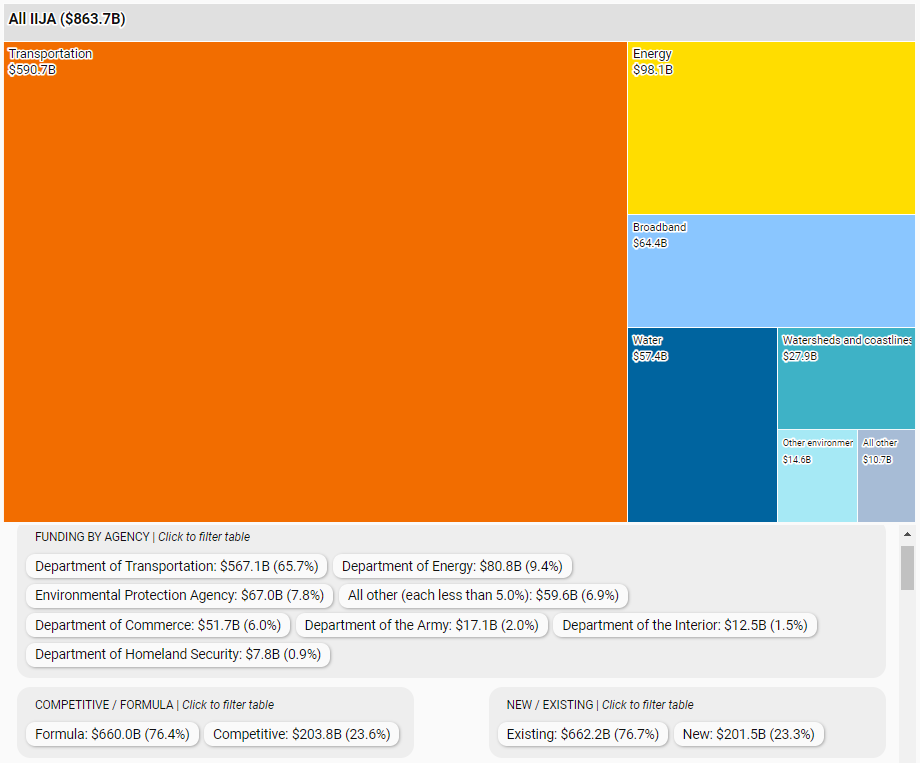The Infrastructure Investment and Jobs Act (IIJA) is the most comprehensive infrastructure law passed by Congress in decades. Unlike most legislation that focuses on a single infrastructure sector like transportation or water, the IIJA addresses all the major sectors to respond to a myriad of long-standing and emerging issues confronting the American people, our economy, and our natural world. It’s not an exaggeration to say the IIJA has the power to fundamentally touch every American community.
But the law’s sheer size and complexity have also made it difficult for the public to understand its mechanics. Take the IIJA’s total federal spending: Is it $1.2 trillion, as quoted in The Washington Post? Or the $1 trillion figure used by The Wall Street Journal? Or the $848 billion figure appearing in the recently-released White House guidebook data? The same goes for the hundreds of unique programs in the 1,000-page law; infographics in national media summarized the law’s major sections, but they didn’t report all the individual programs under those headings. Meanwhile, lobbyists often put their IIJA deep-dives behind paywalls or focus strictly on one infrastructure sector.
The IIJA is too big and too important to have these kinds of information gaps. What practitioners, researchers, journalists, and others need is a single place to view every program the law funds, assess key characteristics of those programs, and have direct access to all the information created by federal agencies, trade associations, and other industry partners who are implementing the new law.
So that’s what we’ve done. The new Brookings Federal Infrastructure Hub consolidates all this knowledge in one place. That includes an interactive database of every IIJA program, spending details, and key characteristics. The information is free to download, and we’ve also designed the interactive to accommodate new data, which we’ll continue to expand in the coming months.
Now that we’ve spent a couple months with the data, we have a better sense of just how big the IIJA is and how it will impact states and communities across the country. Here’s what we’ve learned.
The infrastructure law is smaller—and more roadway-focused—than you may think
Despite what news headlines suggest, the IIJA is almost certainly not a $1 or $1.2 trillion law. Instead, our calculations estimate the total spending will reach about $864 billion over five years. This includes all the programs which received upfront appropriations within the law, plus guaranteed spending authorized through the Highway Trust Fund’s contract authority (which is a complex accounting system, if you’re interested). For all other programs, we estimated potential spending based on the IIJA’s authorizations.

What’s without question is that the IIJA is primarily a transportation law. We estimate $591 billion out of $864 billion in total spending (or 68%) will go to transportation programs. And within the transportation programs, $361 billion goes directly to various highway, roadway, and bridge programs. For the federal government, the age of big roadway spending continues for at least another five years, even if many of those programs now allow greater flexibility to support climate and equity goals.
Despite the enormous spending on roadways, the IIJA is so comprehensive and large that there is still significant funding for many other priorities. The $54 billion combined spending on drinking and clean water programs at the Environmental Protection Agency (EPA) is long overdue for keeping people and our watersheds safe. The $45 billion committed to broadband deployments is the most significant federal telecommunications investment in decades. The country will spend over $29 billion to make electricity generation, transmission, and distribution more reliable and resilient. Overall, we count 115 distinct programs, sub-programs, and set-asides that should receive at least $1 billion in funding.
The law could launch over 100 new federal infrastructure programs
The IIJA is evidence that Congress is willing to take chances and try new approaches to solving shared challenges. Assuming future congressional appropriators fund every program within the law, then the IIJA will have launched 129 new federal infrastructure programs or set-asides. It’s an enormous expansion in programming, and will create real opportunities for the executive branch to rethink infrastructure administration over the next five years.
The bulk of these new programs (86) are competitive, meaning executive leadership in the associated agencies will have wide latitude to set the program’s initial rules and designate the first few years of awardees. The Department of Transportation’s leadership team will have the most opportunities, with 34 new programs and $37 billion to spend. The largest new program here is the $12 billion Bridge Investment Program, which could address the kinds of dangerous and costly situations seen on the Brent Spence and Hernando de Soto bridges over the past year. Leadership at the Department of Energy will have similar opportunities to launch 24 new competitive grant programs totaling $33 billion. These include six programs, funded with $6.28 billion, to improve battery processing and manufacturing.
Key audiences should follow these new programs closely. For journalists, it’s important to track how these programs operate (including the initial rules) and what places and projects win awards. Those decisions will be the easiest place for the Biden administration to convert their policy priorities into physical investments. For state and local practitioners, it’s imperative to review the new rules once announced and determine which grants could be obtainable. Trade associations will continue to be instrumental here too, and we include links to many of their updated websites.
The IIJA greatly expands competitive grant-making—but this is still a formula-driven law
The growth in competitive grant-making was a major storyline following the IIJA’s passage, and for good reason. Leadership at all the major federal infrastructure agencies will now have greater authority to direct federal resources than they did before, allowing agency leaders to pursue major national goals such as climate resiliency and safer streets. Those competitive grants aren’t the law’s core components, however.
A total of $660 billion—or 76% of the entire law—either gets delivered directly to states and localities via formula funding or to specific federal agencies for predetermined activities such as research or product monitoring. The law commits most of this formula spending to the transportation sector, where funds primarily flow to state highway programs and transit agencies. The EPA saw an increase in water funding, with distributions already reaching states. There are also new formula programs, including the $42 billion broadband capital account.
This kind of size discrepancy has a functional implication for communities across the country: Formula programs will often have a far larger impact on what kinds of projects get constructed within their jurisdictions. It also presents a complex puzzle around where to commit limited personnel hours. Mayors, county executives, and other leaders will need to balance how much time and energy they spend lobbying state partners on how to spend formula dollars against building applications for competitive grants those local leaders would directly control. Each has a different set of risks, and additionally, state and local leaders will need to make IIJA-related decisions at the same time they’re already managing American Rescue Plan Act funding.
Congress will still be the arbiter of the law’s future reach
Once the House and Senate passed the IIJA, the major responsibility for the law’s implementation fell to the executive branch. However, that does not mean Congress’ work is done. While the IIJA does provide an unusually large amount of upfront appropriations to many programs, Congress’ annual appropriations process will still influence the future size and scope of those programs—including the potential to claw back money.
That means the politics around the infrastructure law are far from over. The results of the 2022 and 2024 federal elections—particularly, which party controls the House and Senate—could have an enormous impact on which programs continue to receive support, which come under greater scrutiny, and how any presidential administration decides to defend their priorities.
The law is a huge achievement, but the work is far from over
Laws like the IIJA don’t come around often. It takes years to build the case for generational investment, and then years more to build trust among insiders and outsiders in order to finalize legislation and secure support. The IIJA is evidence that Washington can still make big bets on the country’s future, and it’s encouraging to see such significant investment made in macro needs such as delivering sustainable transportation, bridging the digital divide, remediating lead pipes, and modernizing the energy grid.
It’s also a complicated law, with far more programming than many in Washington and across the country are used to. Yet considering the amount of money that will be spent and the stakes if we don’t get the investments right, it’s essential that practitioners, researchers, journalists, and others can understand the law’s mechanics. We hope our Brookings Federal Infrastructure Hub can help build the understanding the country needs to take advantage of this opportunity.
-
Acknowledgements and disclosures
Thank you to Mona Tong for research assistance.






Commentary
Introducing the Brookings Federal Infrastructure Hub: A comprehensive guide to the infrastructure law
February 10, 2022